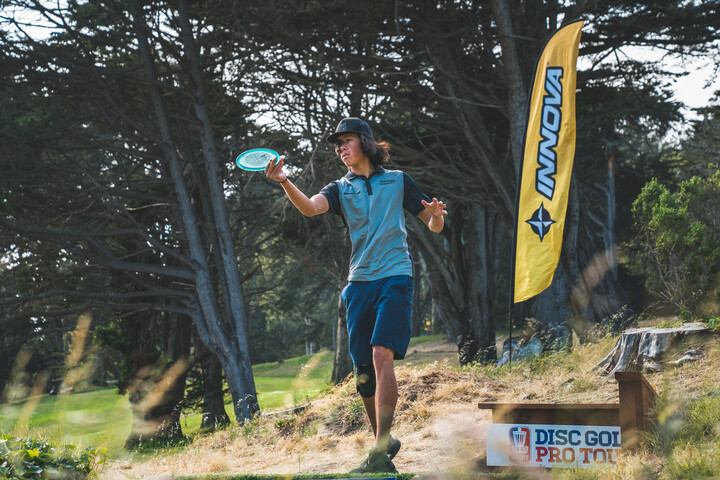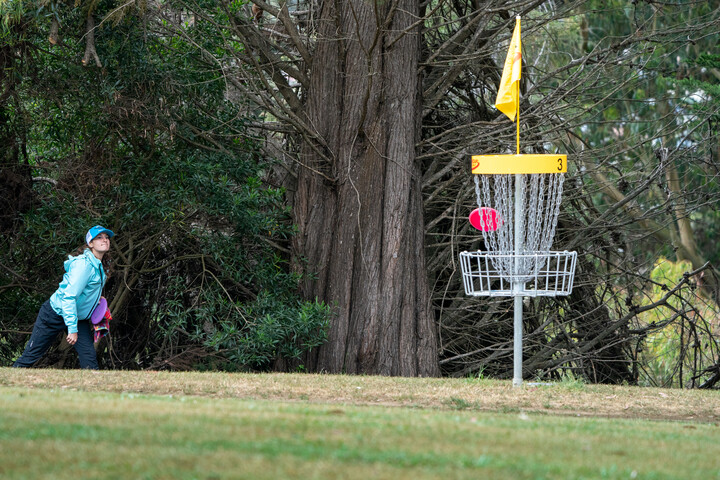Disc Golf Dictionary, Volume 1: Flight Basics
When you start playing disc golf, you will hear a lot of new terms referring to throwing styles, shot shapes and scoring. It can be a little intimidating for a beginner. Eventually, the unique terminology of disc golf will all make sense and you’ll find yourself saying all these same funny words and phrases.
In this DGU Blog series, we will break down “The Disc Golf Disc-tionary,” so to speak. We’ll provide a repository of common and not-so-common disc golf terminology. Consider these posts your cheat sheets!
Today, let’s focus on some of the most common lingo you will hear as a player out on the disc golf course or while watching professional disc golf tournament coverage on YouTube.
Disc Golf Throws
There are many different throw types you can use to get a disc from the tee box and ultimately in the basket. In fact, there will be an entire article about all the different throw types, angle of release, and more in future posts in this series (so stay tuned). We’ll cover some of the most basic throwing terms now:
Backhand – A backhand throw is the most commonly used in disc golf, where you pull the disc back across your body and follow through with your lead shoulder initially turned away from the target.
 Forehand (Sidearm) – This is a sidearm throwing motion, where you typically are facing the target more and the disc is thrown with the opposite rotation of a backhand. Also known as a “flick.”
Forehand (Sidearm) – This is a sidearm throwing motion, where you typically are facing the target more and the disc is thrown with the opposite rotation of a backhand. Also known as a “flick.”
RHBH – Shorthand for right-hand backhand throw when talking about form or disc flight characteristics.
LHBH – Shorthand for left-hand backhand throw.
RHFH – Shorthand for right-hand forehand throw.
LHFH – Shorthand for left-hand forehand throw.
Hyzer – This refers to the release angle of your disc when it comes out of your hand. A hyzer throw will have the disc angled downward and will typically result in a flight that fades out to the left on RHBH throws.
Anhyzer – This is the opposite release angle of a hyzer throw, where the disc is tilted upward toward you as you release, resulting in a flight that drifts initially to the right. For more information, see our article explaining more about the intricacies of Hyzer vs. Anhyzer throws.
Drive – This is your tee shot. A player tees off from a designated teeing area (tee pad) for their drive.
Fairway Shot – A long approach or lay-up with a goal of advancing your disc closer to the target from a fairway lie.
 Putt – “Drive for show, putt for dough.” Putts are most important throw type in disc golf. Putts are the most common way to complete a disc golf hole and decribe your attempts at making your disc in the basket from close range, usually with a blunt-edged, slow-speed putt and approach disc.
Putt – “Drive for show, putt for dough.” Putts are most important throw type in disc golf. Putts are the most common way to complete a disc golf hole and decribe your attempts at making your disc in the basket from close range, usually with a blunt-edged, slow-speed putt and approach disc.
Jump Putt (or Step Putt) – Outside of the 10-meter circle around the basket, a disc golf player can leave the ground after releasing their putt. By jumping forward and landing in front of the marker disc, a player can gain distance for a long-range putt.
Approach Shot (Upshot) –Your approach shot to the basket, often thrown with a mid-range disc or putt and approach disc for control and accuracy.
Escape Shot – Often from a tough lie (like deep in the woods), you are scrambling to escape from a bad lie to either simply get back in the fairway or to “go for it” and reach the basket.
Scramble – When one or more of your throws is off the fairway and you are able to save at least a par.
Disc Golf Flight Characteristics
Innova uses a flight number rating system to give you a better idea of how different discs are designed to fly. Here are some of the terms you will need to know:
Stability – This refers to how stable the disc is in terms of how much it will naturally want to fade out at the end of the flight. Different discs are engineered with different levels of stability, from very overstable to very understable.
Overstable – Overstable discs are meant to be beefy for control and accuracy, with predictable flight pattern that will always fight back to the left on RHBH throws.
Understable – Understable discs are just the opposite. They naturally will want to pan out right on RHBH throws. The faster the disc is thrown, the more it wants to turn.
 Flight Numbers – These are the four numbers displayed on the front of any Innova disc representing its speed, glide, turn and fade ratings.
Flight Numbers – These are the four numbers displayed on the front of any Innova disc representing its speed, glide, turn and fade ratings.
Speed – This is the first flight number you will see listed on Innova discs. The speed of a disc is how fast it must be thrown to achieve its designed flight characteristics. The higher the speed, the faster the disc (i.e. distance drivers with sharp edges). Putters and approach discs (mid-ranges) are the lowest-speed discs.
Glide – This refers to the natural glide of the disc, as in how long it tends to stay in the air on average throws. Discs with a lot of glide may provide more distance with less effort, but they don’t offer as much control as discs with lower glide ratings.
Turn – This refers to the initial high-speed understability of the disc, meaning how much it wants to initially drift to the right on RHBH throws.
Fade – Refers to the low-speed stability of a disc. How much will it move to the left when it runs out of power?
(For more information on flight numbers and flight ratings, click here.)
If you can’t tell, we’re just starting to scratch the surface of disc golf terminology. Stay tuned to the DGU Blog in coming weeks for more installments of our Disc Golf Dictionary series to learn more about the words and phrases you need to know as an avid or beginner disc golfer.
